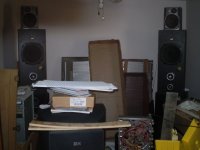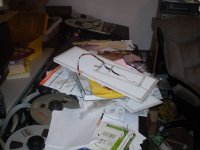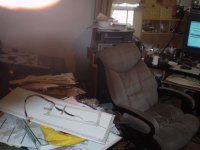Yes, like this
http://www.diyaudio.com/forums/planars-exotics/171441-hornloading-heil-amt1-3.html#post2510268
Will it help?
I don't see why not.
It would be intersting and real easy to find out.
I have been contemplating something just like this for quite some time.
I'm just not sure how to go about deterimining and predict the horn shape and dimensions.
It can't be that hard though.
I guess the best way is to just do it and see what comes out.
I won't be able try any thing yet as I have to finnish setting up my equipment and iron out A few minor bugs.
Clean the place up so that I can have some room to work In.
As well as build two of my variable bias supplies and put them in a proper box so that the H.V. doesn't find it's way back into my equipment.
Like it did last year. jer
http://www.diyaudio.com/forums/planars-exotics/171441-hornloading-heil-amt1-3.html#post2510268
Will it help?
I don't see why not.
It would be intersting and real easy to find out.
I have been contemplating something just like this for quite some time.
I'm just not sure how to go about deterimining and predict the horn shape and dimensions.
It can't be that hard though.
I guess the best way is to just do it and see what comes out.
I won't be able try any thing yet as I have to finnish setting up my equipment and iron out A few minor bugs.
Clean the place up so that I can have some room to work In.
As well as build two of my variable bias supplies and put them in a proper box so that the H.V. doesn't find it's way back into my equipment.
Like it did last year. jer
Attachments
Last edited:
I came home today, logged into DIY audio and was suprised to see responses to my question on horn loading ESL drivers. Thanks everyone. Here is a link showing a few compression drivers and a few horns. I have horns is my Klipschorn loudspeaker. I have thought about taking my headphones and placing them up against the back of the midrange horn in my Klipschorn. I have not done it, but the thought did occupy a few brain cells for a while.
Selenium Products | Critesspeakers.com
Should I start a new thread?
Selenium Products | Critesspeakers.com
Should I start a new thread?
Hi everyone,
Apologises for the interruption here…
I and a techie friend of mine would like to build a pair of your fantastic esl headphones.
I might be lucky enough to have access to a CNC milling machine and was wondering if anyone would be kind enough to give a few tips…?
Firstly what is the average price can I expect to pay for materials, for headphones and amp?
What kind of materials do you guys use for you’re stator panels and insulating material? Would normal acrylic be suitable for insulating / spacing material?
Any amp suggestions?
Can anyone here share the necessary files for the CNC machine?
My initial idea is to take a block of hard wood mill it into a dome shape on the outside and mill a cavity in the middle, then put in a sheet of insulating material and drop in the layers and then bolt in with nylon bolts. Is this a good idea or is it better acoustics if a leave the back of each speaker open?
If I can get access to my friends milling machine then I can do a batch for you friendly folk, just need some fairly good designs.
Thanks,
Matt
Apologises for the interruption here…
I and a techie friend of mine would like to build a pair of your fantastic esl headphones.
I might be lucky enough to have access to a CNC milling machine and was wondering if anyone would be kind enough to give a few tips…?
Firstly what is the average price can I expect to pay for materials, for headphones and amp?
What kind of materials do you guys use for you’re stator panels and insulating material? Would normal acrylic be suitable for insulating / spacing material?
Any amp suggestions?
Can anyone here share the necessary files for the CNC machine?
My initial idea is to take a block of hard wood mill it into a dome shape on the outside and mill a cavity in the middle, then put in a sheet of insulating material and drop in the layers and then bolt in with nylon bolts. Is this a good idea or is it better acoustics if a leave the back of each speaker open?
If I can get access to my friends milling machine then I can do a batch for you friendly folk, just need some fairly good designs.
Thanks,
Matt
Hi Matt,
The material I use is mainly one sided PCB. It is cheap, strong and has enough electrical insulation. I use the same material for spacers and stators.
Yes, I can share with you my design. Let me know which design you like.
About the headphone enclosure, I prefer open back type. It just sounds more natural for me.
Wachara C.
The material I use is mainly one sided PCB. It is cheap, strong and has enough electrical insulation. I use the same material for spacers and stators.
Yes, I can share with you my design. Let me know which design you like.
About the headphone enclosure, I prefer open back type. It just sounds more natural for me.
Wachara C.
Hi @all, thought i might aswell introduce myself here. I'm Munich-based, interested in Electrostatic Headphones for quite a while and now plan to build a DIY set. For inspiration, i thought i can start with a repair of some old Koss ESP 6. I have three sets of Koss, 2x6 and one 9. I got the electronics refurbished in one 6, they do very well, however, i managed to arc one membrane (still have 5 to go). The power source of the model 9 is also in working condition, but i will replace the caps and diodes aswell.
I really love the KOSS ESPs as there are not many choices in closed back electrostatic cans, at least at my kind of affordability range.. I work in a rather loud environment, many PC coolers around - so open back cans are not a choice for me.
What I thought might be interesting for this thread: look at the picture of the KOSS ESP taken apart:
There are actually two sheets of mylar directly in touch. The one with conductive covering is very conductive (~1 Ohm) and feels very stiff, like it was stretched a lot more than what I currently achieve on my stretching rig. Maybe its the coating that makes them that stiff.
You can see the whitish plastic spacer and the black spacer dot in the middle on the right side of the image. This is symmetric and can also be felt behind the painted membrane. The painted membrane feels thicker than the humidity barrier.
You can see the holes from arcing, i scraped off the burnt mylar a little and will test the membranes later. After the accident, they discharged quite a lot, no surprise as the black burnt membrane was virtually touching the stators.
The coating is painted on, just at the area where it is needed. It seems to me like they were trying to get the humidity barrier and a protection from arcing in one, by making this membrane 'sandwich'.
My question: Do you guys think I should give it a try with less conductive coating for the repair? Or try to replicate this very high conduction coating? Do you think the guys from KOSS had good reason to make it that conductive (weak self biasing would otherwise lead to long charging time?) or did they just not know better?
I really love the KOSS ESPs as there are not many choices in closed back electrostatic cans, at least at my kind of affordability range.. I work in a rather loud environment, many PC coolers around - so open back cans are not a choice for me.
What I thought might be interesting for this thread: look at the picture of the KOSS ESP taken apart:
An externally hosted image should be here but it was not working when we last tested it.
There are actually two sheets of mylar directly in touch. The one with conductive covering is very conductive (~1 Ohm) and feels very stiff, like it was stretched a lot more than what I currently achieve on my stretching rig. Maybe its the coating that makes them that stiff.
You can see the whitish plastic spacer and the black spacer dot in the middle on the right side of the image. This is symmetric and can also be felt behind the painted membrane. The painted membrane feels thicker than the humidity barrier.
You can see the holes from arcing, i scraped off the burnt mylar a little and will test the membranes later. After the accident, they discharged quite a lot, no surprise as the black burnt membrane was virtually touching the stators.
The coating is painted on, just at the area where it is needed. It seems to me like they were trying to get the humidity barrier and a protection from arcing in one, by making this membrane 'sandwich'.
My question: Do you guys think I should give it a try with less conductive coating for the repair? Or try to replicate this very high conduction coating? Do you think the guys from KOSS had good reason to make it that conductive (weak self biasing would otherwise lead to long charging time?) or did they just not know better?
Hi TomMUC,
I'm so very interested to see inside of your KOSS. Your picture is too small. Is it possible that you post a bigger picture?
How are the stators look like? What are they made of?
I think if you just want to repair the headphone, you should follow what KOSS has done. They must know what they were doing.
I'm surprised to hear that there are two sheets of Mylar directly in touch. Do you mean that there is no spacer in between the two sheet of Mylar? How does the conductive Mylar get charged then?
Wachara C.
I'm so very interested to see inside of your KOSS. Your picture is too small. Is it possible that you post a bigger picture?
How are the stators look like? What are they made of?
I think if you just want to repair the headphone, you should follow what KOSS has done. They must know what they were doing.
I'm surprised to hear that there are two sheets of Mylar directly in touch. Do you mean that there is no spacer in between the two sheet of Mylar? How does the conductive Mylar get charged then?
Wachara C.
Sorry for the small image, it should have been an enlargable thumbnail. Try bildercache - Bild: DSC_7536-4.JPG
Stators look like drilled PCB. The two sheets of mylar do touch directly, no spacers. On the picture, there is a sheet of mylar on top of both halfes of the driver, when put together they touch. As you hopefully can see from the picture only a part of one of the mylars is painted with the conductive coating. I guess as there is not much air in between the mylar sheets they will stick together when the driver is closed. So you have something like a mylar sheet double thickness charged on the 'inside'.
If you feel more pictures would clarify things, I can take some more.
If you feel more pictures would clarify things, I can take some more.
Hi TomMUC,
Thanks for the bigger picture.
It's my first time to see this kind of double diaphragms configuration. The only advantage of this kind of double diaphragms that I can think of is the protection against humid weather. However, the driver might lose a bit of sensitivity due to the total heavier mass of the diaphragm.
How did you arch the driver? If you were to put everything back together, would it still arch? From the picture, it looks like the spacers are some kind of silicone. Have you measured the thickness?
Wachara C.
If you could take more pictures, I would really appreciate them.
Thanks for the bigger picture.
It's my first time to see this kind of double diaphragms configuration. The only advantage of this kind of double diaphragms that I can think of is the protection against humid weather. However, the driver might lose a bit of sensitivity due to the total heavier mass of the diaphragm.
How did you arch the driver? If you were to put everything back together, would it still arch? From the picture, it looks like the spacers are some kind of silicone. Have you measured the thickness?
Wachara C.
If you could take more pictures, I would really appreciate them.
The driver arced probably when a friend unplugged his mp3 player at a high volume setting on my NAD C370 ca. 3/4 of maximum level, soft clipping was switched off. With a good condition KOSS ESP 6 I managed to overheat the C370 before - connected directly at the speaker posts of course. These cans can deliver high sound volumes when electronics and drivers are intact.
Btw. after scraping away the burnt remains, the driver sounds good again I just tested it. I'm not sure if i will replace the membrane or rather build an independent prototype for experimentation right now.
I just tested it. I'm not sure if i will replace the membrane or rather build an independent prototype for experimentation right now.
Maybe i can try to measure the thickness of the spacers at work next week with a calliper, so far i took some more pictures including a differnt driver, note the different electrical connection of the membrane and the missing spacer in the middle.
bildercache - Bild: DSC_7544.JPG
bildercache - Bild: DSC_7543.JPG
bildercache - Bild: DSC_7554.JPG
bildercache - Bild: DSC_7537.JPG : The screws serve as contacts, the stators are connected via the top and bottom screws, the membrane via one of the less curved side, the last screw is without electric function. In some versions there is a cable running along the screw, other versions have the cable run in a different channel and are then connected with latches in contact with the screws. (see next pictures).
bildercache - Bild: DSC_7539.JPG
Btw. after scraping away the burnt remains, the driver sounds good again
Maybe i can try to measure the thickness of the spacers at work next week with a calliper, so far i took some more pictures including a differnt driver, note the different electrical connection of the membrane and the missing spacer in the middle.
bildercache - Bild: DSC_7544.JPG
bildercache - Bild: DSC_7543.JPG
bildercache - Bild: DSC_7554.JPG
bildercache - Bild: DSC_7537.JPG : The screws serve as contacts, the stators are connected via the top and bottom screws, the membrane via one of the less curved side, the last screw is without electric function. In some versions there is a cable running along the screw, other versions have the cable run in a different channel and are then connected with latches in contact with the screws. (see next pictures).
bildercache - Bild: DSC_7539.JPG
- Status
- This old topic is closed. If you want to reopen this topic, contact a moderator using the "Report Post" button.
- Home
- Amplifiers
- Headphone Systems
- Has anybody made an ELS headphone?


